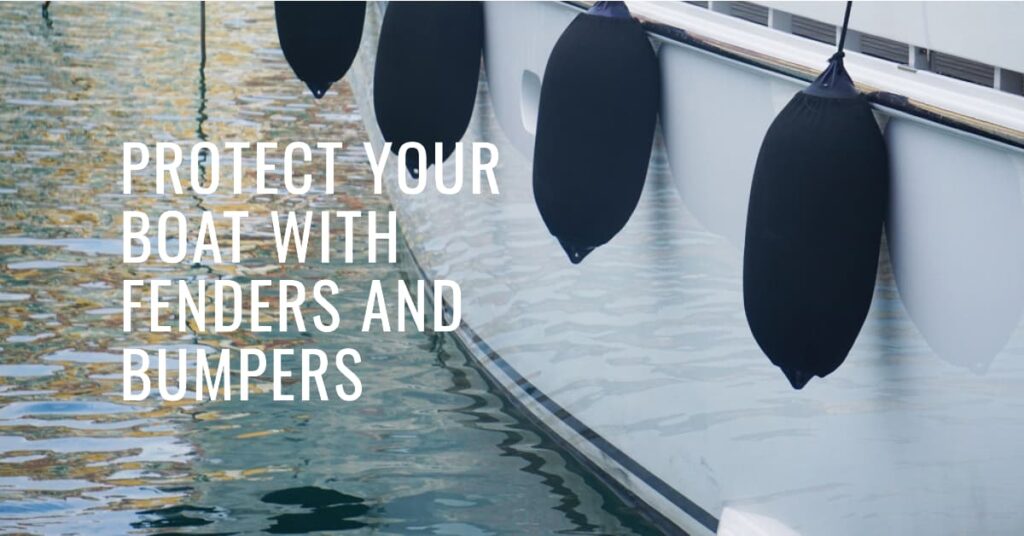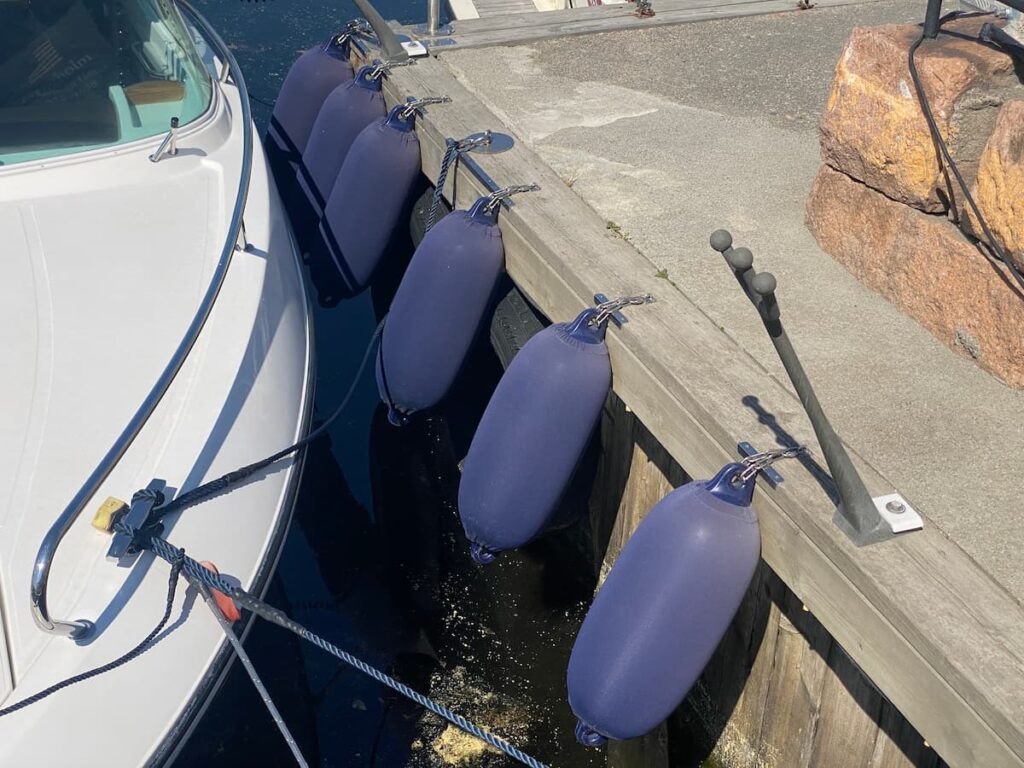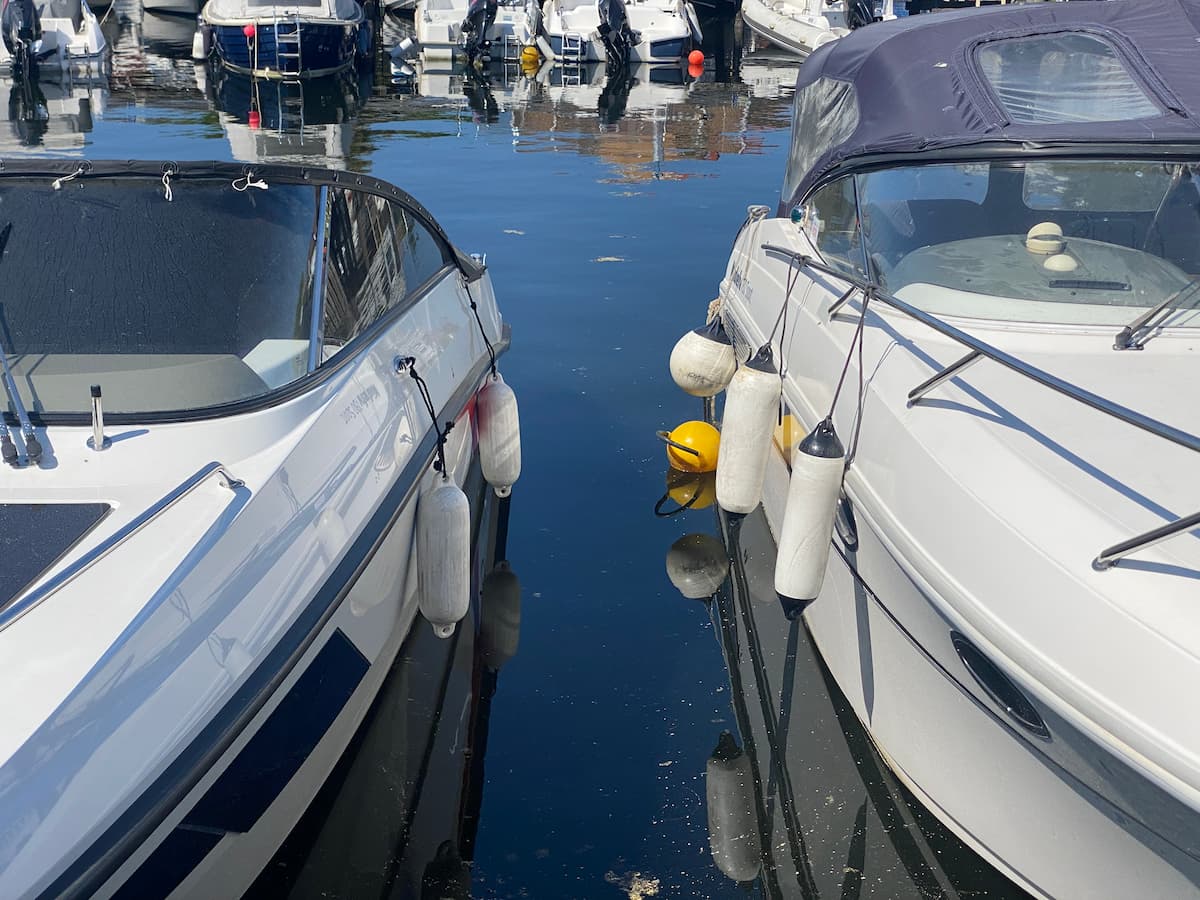Boat fenders and bumpers are essential accessories for any boat owner. They protect boats from damage caused by impacts on other boats, docks, or other objects in the water.
Boat fenders, also known as boat bumpers, are made of durable materials such as vinyl or rubber and come in various sizes and shapes to fit different types of boats.
Boat fenders are designed to absorb the impact of collisions and prevent damage to the boat’s hull. They are attached to the boat’s sides or dock using ropes or straps, and they provide a cushion between the boat and the hard surface.
Boat bumpers are also used to protect boats from damage caused by waves, wind, and other environmental factors. They help prevent scratches, dents, and other types of damage that can occur during docking or mooring.
Overall, boat fenders and bumpers are essential accessories for boat owners. They provide protection against damage caused by collisions, waves, and other environmental factors. Boat owners should choose the right size and type of fender or bumper for their boats to ensure maximum protection.
Here we prepared a list of the 5 best black boat fenders you can find, but now let’s dive deeper into types of fenders, materials, maintenance, and proper use.

Types of Boat Fenders and Bumpers
Cylindrical Fenders
Cylindrical fenders are one of the most common types of fenders used on boats. They are typically made of rubber or plastic and come in a variety of sizes and colors.
The size range of these cylindrical fenders can span from a petite 10 inches to an impressive 72 inches in length, and they are often available in an array of colors such as the classic white, black, and blue, to more vibrant hues like red and yellow.
Cylindrical fenders are designed to be hung vertically from the boat’s gunwale or dock to protect the boat from damage caused by contact with other boats or the dock. They are easy to install and remove, making them a popular choice for boaters of all experience levels.
Vinyl Fenders
Vinyl fenders are another popular type of boat fender. They are made of a soft, pliable vinyl material that is resistant to UV rays and other environmental factors. Vinyl fenders come in a variety of shapes and sizes, including cylindrical, round, and flat.
They are typically hung vertically from the boat’s gunwale or dock using a rope or strap. Vinyl fenders are easy to clean and maintain, making them a popular choice for boaters who want a low-maintenance fender.
Inflatable Fenders
Inflatable fenders are a newer type of boat fender that has gained popularity in recent years. They are made of a durable, puncture-resistant material that can be inflated to provide protection for the boat. Inflatable fenders come in a variety of shapes and sizes, including cylindrical, round, and flat.
They are typically hung vertically from the boat’s gunwale or dock using a rope or strap. Inflatable fenders are easy to store and transport, making them a popular choice for boaters who want a fender that is easy to use and store.
Overall, the type of boat fender or bumper that a boater chooses will depend on their individual needs and preferences. Cylindrical fenders are a popular choice for their ease of use and installation, while vinyl fenders are a great option for boaters who want a low-maintenance fender.
Inflatable fenders are a newer option that is gaining popularity for their ease of storage and transport. Regardless of the type of fender chosen, it is important to ensure that it is properly installed and maintained to provide maximum protection for the boat.

Importance of Boat Fenders and Bumpers
Boat fenders and bumpers are essential accessories for any boat owner. They are designed to protect the hull of the vessel from impact damage when moored or docked. Boat fenders and bumpers are made of durable materials such as rubber, vinyl, or foam. They are available in various sizes and shapes to suit different types of boats.
The protection provided by boat fenders and bumpers is crucial in preventing damage to the hull of the vessel. Without them, the boat can suffer from scratches, dents, and other forms of impact damage. This can be costly to repair and can also affect the resale value of the boat.
Boat fenders and bumpers also protect the gelcoat of the boat. The gelcoat is a protective layer that covers the fiberglass hull of the vessel. It is susceptible to damage from impact, UV rays, and other environmental factors. Boat fenders and bumpers provide an additional layer of protection to the gelcoat, ensuring it remains intact.
Investing in boat fenders and bumpers is a wise decision for any boat owner. They are relatively inexpensive and can save the owner a lot of money in repair costs. They also help to maintain the appearance of the boat, ensuring it remains in good condition for longer.
In conclusion, boat fenders and bumpers are an essential investment for any boat owner. They provide protection to the hull and gelcoat of the vessel, preventing damage from impact and other environmental factors. Boat fenders and bumpers are available in various sizes and shapes and are relatively inexpensive.

Boat Fenders and Bumpers Material
Boat fenders and bumpers are essential components of any watercraft. They protect the boat from damage caused by contact with docks, pilings, and other boats. The material used to manufacture fenders and bumpers is crucial in determining their effectiveness, durability, and ability to withstand harsh marine environments.
Marine-grade vinyl is a popular choice for boat fenders and bumpers. This material is resistant to water, UV rays, and abrasion, making it ideal for use in harsh marine environments. It is also easy to clean and maintain, ensuring that the fenders and bumpers remain in good condition for an extended period.
Another material commonly used in the manufacture of boat fenders and bumpers is PVC. This material is durable and can withstand heavy impact without cracking or breaking. It is also resistant to UV rays and water, ensuring that it can last for many years without deteriorating.
Rubber is another material used in the manufacture of boat fenders and bumpers. It is flexible and can absorb impact, making it ideal for use in protecting boats from damage caused by contact with other boats or docks. However, rubber fenders and bumpers are not as durable as those made from marine-grade vinyl or PVC, and they may require frequent replacement.
In conclusion, the material used in the manufacture of boat fenders and bumpers is crucial in determining their effectiveness and durability. Marine-grade vinyl and PVC are popular choices due to their resistance to water, UV rays, and abrasion, while rubber is flexible and can absorb impact. Boat owners should consider these factors when selecting fenders and bumpers for their watercraft.
Proper Placement and Height of Fenders and Bumpers
When it comes to protecting a boat from damage caused by collisions with docks, other boats, or other objects, fenders and bumpers are essential. However, simply having fenders and bumpers on a boat is not enough. Proper placement and height of these protective devices is also crucial.
Placement
The placement of fenders and bumpers on a boat is important for protecting the boat from damage. When docking, fenders should be placed at the points where the boat is most likely to come into contact with the dock or other boats. This includes the bow, stern, and amidships.
It is also important to consider the height of the dock when placing fenders. If the dock is low, fenders should be placed lower on the boat to protect the hull. If the dock is high, fenders should be placed higher on the boat to protect the topsides.
Height
The height of fenders and bumpers is also important for protecting a boat. Fenders should be placed at a height that allows them to be compressed by the dock or other object without allowing the boat to come into contact with the object.
The height of fenders can be adjusted based on the tide. As the tide rises, fenders should be adjusted higher on the boat to maintain the correct height. As the tide falls, fenders should be adjusted lower on the boat.
Number of Fenders
The number of fenders needed depends on the size of the boat and the conditions in which it will be docked. As a general rule, it is recommended to have at least one fender for every 10 feet of boat length.
Clove Hitch
When attaching fenders to a boat, a clove hitch is the recommended knot to use. This knot allows for easy adjustment of the fender height and can be quickly released when needed.
Overall, proper placement and height of fenders and bumpers is essential for protecting a boat from damage. By following these guidelines, boat owners can ensure that their vessels are protected when docking.
Fenders and Bumpers for Different Types of Boats
Motor Yachts
Motor yachts are large and heavy boats that require fenders and bumpers that can handle their size and weight. The fenders and bumpers should be placed strategically to protect the boat from damage when docking or mooring. In general, cylindrical fenders are recommended for motor yachts, as they provide excellent protection and can be easily adjusted to the appropriate height.
Sailboats
Sailboats come in various sizes and shapes, and the fenders and bumpers needed will depend on the boat’s dimensions and the conditions in which it will be used. For smaller sailboats, such as dinghies, round fenders are often sufficient. For larger sailboats, cylindrical fenders are recommended. Sailboats that are used in rough conditions or in areas with strong currents may require additional fenders or bumpers to ensure adequate protection.
Ski Boats
Ski boats are smaller boats that are designed for speed and maneuverability. They typically require smaller fenders and bumpers that can be easily stored when not in use. In general, ski boats require fewer fenders and bumpers than larger boats, as they are less likely to be damaged during docking or mooring.
Bass Boats
Bass boats are designed for fishing and are typically smaller than other types of boats. They require fenders and bumpers that can be easily stored when not in use, and that provide adequate protection when docking or mooring a boat. In general, round fenders are recommended for bass boats, as they are easy to store and provide sufficient protection.
Runabouts
Runabouts are small, fast boats that are designed for recreational use. They typically require smaller fenders and bumpers that can be easily stored when not in use. In general, round fenders are recommended for runabouts, as they are easy to store and provide sufficient protection. Runabouts that are used in rough conditions or in areas with strong currents may require additional fenders or bumpers to ensure adequate protection.
Tying and Loading of Boat Fenders and Bumpers
When it comes to boating, ensuring the safety of the vessel and its passengers is of utmost importance. One way to do this is by properly tying and loading boat fenders and bumpers.
Tying boat fenders and bumpers to the dock or cleat can prevent damage to both the boat and the dock. It is important to use the correct knot, such as the cleat hitch or bowline, to ensure that the fender or bumper stays secure. It is recommended to tie the fender or bumper at the midpoint of the boat’s freeboard to provide the most protection.
Loading boat fenders and bumpers onto the vessel is also an important step. It is recommended to load them onto the boat before departing the dock to ensure they are easily accessible when needed. It is important to properly secure them to prevent them from rolling or sliding around while underway.
When tying the fender or bumper to the boat, it is important to use a fender line that is appropriate for the weight and size of the fender or bumper. A good rule of thumb is to use a line that is at least twice the length of the fender or bumper.
In summary, tying and loading boat fenders and bumpers is an important step in ensuring the safety of the vessel and its passengers. Properly tying the fender or bumper to the dock or cleat and loading them onto the boat before departure can prevent damage and provide the necessary protection. Using the correct knot and appropriate fender line can help ensure that the fender or bumper stays secure.
Maintaining Boat Fenders and Bumpers
Boat fenders and bumpers are essential parts of any boat, protecting the hull from damage and ensuring the safety of passengers. Maintaining these components is crucial to ensure their longevity and effectiveness.
One of the first steps in maintaining boat fenders and bumpers is to clean them regularly. Dirt, salt, and other debris can accumulate on the surface, causing damage and reducing their lifespan. A simple solution of soap and water can be used to clean them thoroughly.
Another important step is to inspect them regularly for signs of wear and tear. Any cracks or splits can weaken the fender or bumper, making it less effective at protecting the boat. If any damage is found, it should be repaired or replaced immediately.
When installing boat fenders and bumpers, it is important to ensure they are properly secured. Loose or improperly secured fenders can cause damage to the hull or even fall off during use.
Painting boat fenders and bumpers can also help protect them from the elements and extend their lifespan. However, it is important to use the appropriate type of paint and follow the manufacturer’s instructions to avoid damaging the fender or bumper.
Boat fenders and bumpers can also be used to protect other parts of the boat, such as lifelines and cushions. When using them for this purpose, it is important to ensure they are properly positioned and secured to avoid causing damage.
Overall, maintaining boat fenders and bumpers is a simple but important task that can help ensure the safety and longevity of your boat. By cleaning them regularly, inspecting them for damage, properly securing them, and using them to protect other parts of the boat, you can enjoy a safe and comfortable boating experience.
Frequently Asked Questions
What is the difference between boat bumpers and boat fenders?
Boat bumpers and boat fenders are both designed to protect a boat from damage when it comes in contact with a dock or another boat. However, there is a difference between them. Boat bumpers are typically made of hard plastic or rubber and are designed to absorb impact. Boat fenders, on the other hand, are inflatable and are designed to provide cushioning and prevent damage to the boat.
What are the bumpers on boats called?
The bumpers on boats are typically called boat fenders or simply fenders. They are available in a variety of shapes and sizes and are made from different materials.
How many fenders should a boat have?
The number of fenders a boat should have depends on the size of the boat and the conditions in which it will be used. As a general rule, a boat should have at least one fender for every 10 feet of boat length. However, it’s always a good idea to have a few extra fenders on board, just in case.
What size boat fenders should I use?
The size of the boat fenders you should use depends on the size of your boat. As a general rule, you should use a fender with a diameter of at least two-thirds the beam of your boat. For example, if your boat has a beam of 10 feet, you should use fenders with a diameter of at least 6.5 inches.
Where can I find boat fenders for sale?
Boat fenders are widely available and can be found at most marine supply stores. They are also available for purchase online from a variety of retailers.
What are the advantages of using inflatable boat fenders?
Inflatable boat fenders have several advantages over traditional hard plastic or rubber fenders. They are lightweight and easy to store, and they can be inflated to the desired level of firmness. In addition, they are less likely to cause damage to a boat or dock if they come in contact with them.
- Comprehensive Guide to Hold Cleaning for Cargo Ships: Ensuring Maritime Safety and Efficiency – October 19, 2024
- Responsibilities of a Fourth Engineer on Cargo Ships – September 10, 2024
- The Role of Cargo Ships in Global Trade – August 22, 2024



